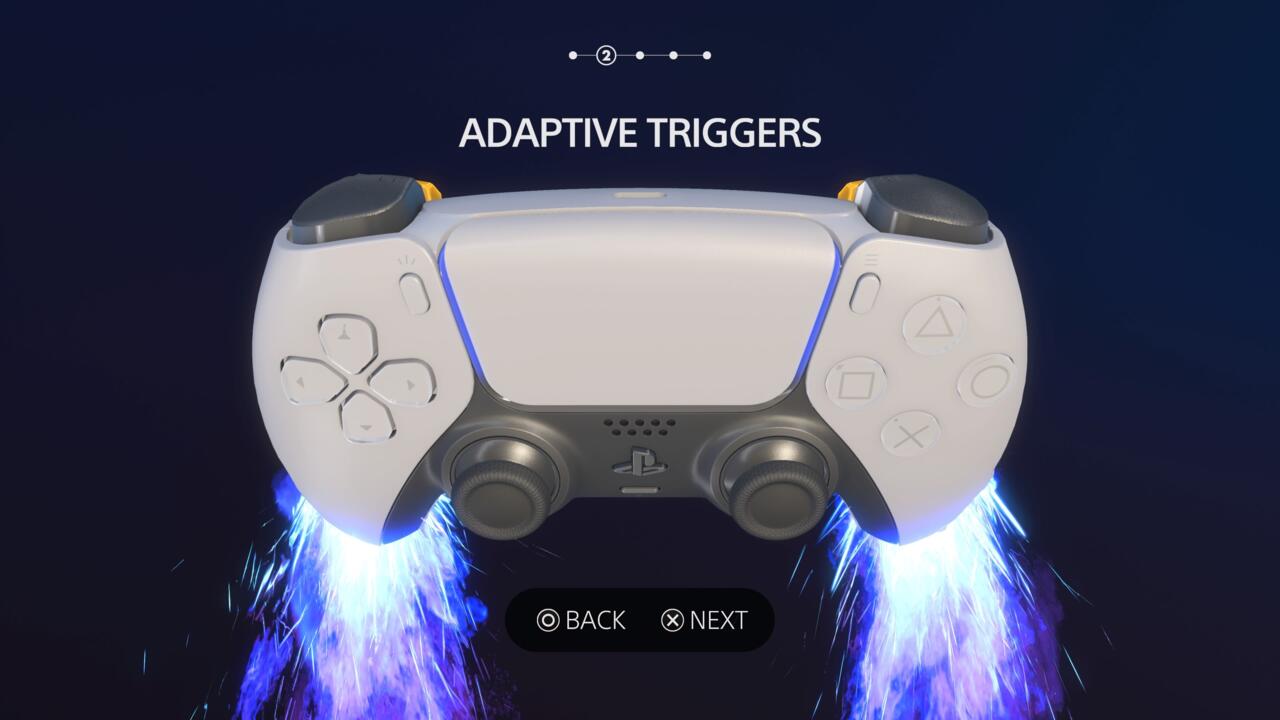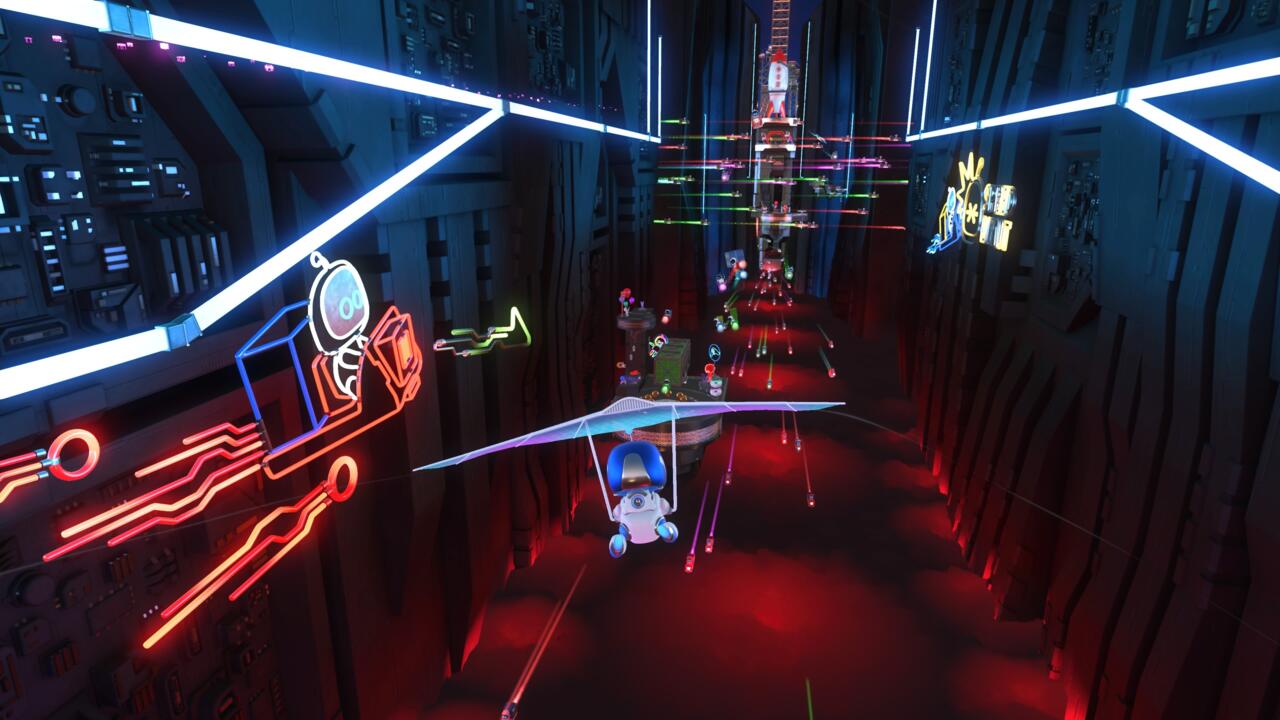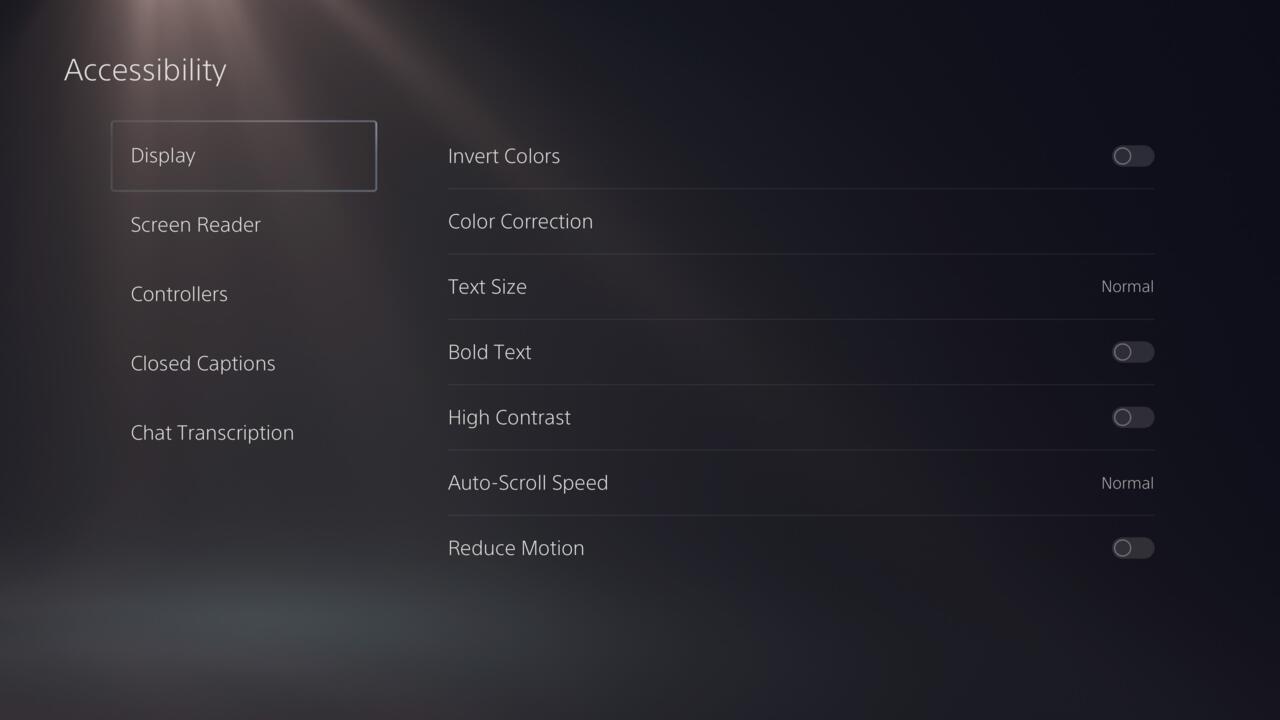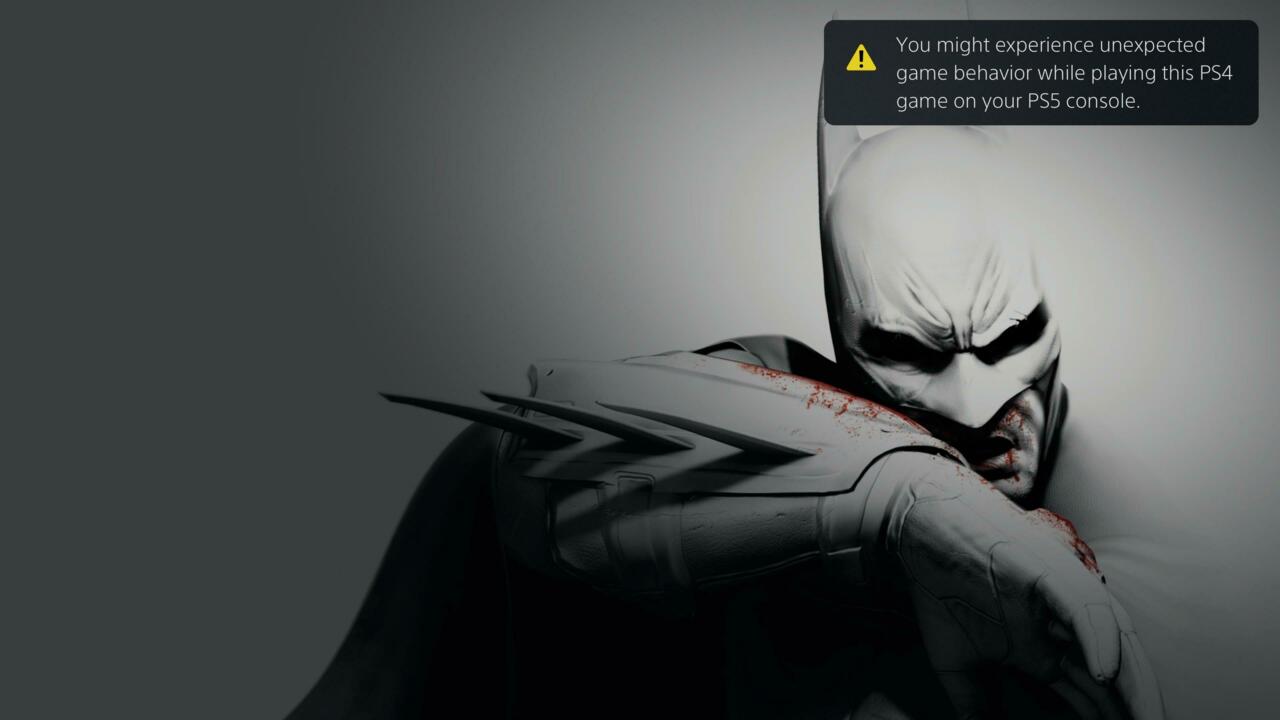The PS4 was a fantastic console, a platform that both indie and AAA games flocked to and shined on. Bolstered by a varied lineup of first-party exclusives, Sony's fourth console commanded the attention of gamers over the past seven years. While the PS4's success was undeniably a good thing for Sony, it leaves the company with the tough challenge of topping itself.
With the PS5, instead of simply releasing a new console with more horsepower, Sony has taken a bolder step to clearly establish that this is a brand-new generation. The PS5's console design speaks to this, looking less like a PlayStation and more like an evil megacorp's cyberpunk headquarters. It's a brash design that looks nice when standing tall and a little strange when resting on its side, but in either orientation it's undeniably eye-catching. The next-generation machine is big, bold, and next to stablemates like the PS4 Pro, downright intimidating.
Though it may be a cold behemoth in its stature, the PS5 is also warm and inviting when turned on. The menus are all reminiscent of the PS4, creating a sense of familiarity that helps users get their feet planted, but it's also stripped down and streamlined to only the necessities. Installed games stand in a line of up to nine titles on the homepage, capped off by a library button that reveals your full collection. This is similar to the PS4, though unfortunately, there's currently no way to organize these games at launch--whatever was used most recently shows up first, and there are no folders. Sorting sizable libraries by the platform is easy, though, allowing you to parse which games are native to the PS5 in just a few button presses.
The DualSense Controller Is Very Impressive
Navigating the PS5's user interface is just as easy. Being able to quickly slide in and out of specific sections, back to your game, and then into the deeper system settings feels more fluid than on PS4. And doing all of this with the new DualSense controller is a delight. It's slightly bigger than the DualShock 4 and features new ergonomics. This extends to the shoulder buttons and triggers, which are now thicker and feel smoother to press. The directional pad and face buttons also feel less stiff--knocking out fighting game inputs feels great--and while the analog sticks are the same size as the DualShock 4's, they feature more grip and a slightly more concave form factor, making them easier to hold on to.
Sony requires you to use the DualSense for all PS5 games, relegating backwards-compatible controllers strictly to PS4 games--you can still navigate the system and launch PS5 games with a DualShock 4, but you will have to switch to a DualSense to actually play them. This may reek of a company pushing a gimmick, but after weeks of testing the controller's unique features, the DualSense's haptic feedback and adaptive triggers have proven themselves to be much more than that.
Astro's Playroom comes with every PS5, and not only is it an enjoyable bite-sized platformer--read our Astro's Playroom review for more details--but it's also a fantastic showpiece for the DualSense controller. As Astro's little robot feet walk on metal floors, over a sandy beach, or across an icy surface, you feel the difference in impact thanks to the controller's enhanced haptic feedback. But where the DualSense truly impresses is with its adaptive triggers. When Astro comes across weapons like a bow or a minigun, the triggers react in kind to differentiate how it feels to use them. Drawing the bow's string instills tension into the trigger, while firing the minigun causes it to pop back as each bullet fires. The DualSense delivers a tangible sensation that enhances the enjoyment of an already cute and charming platformer.
Then there's Spider-Man, where the DualSense's unique features are utilized in more subtle ways. Feeling the subway tracks beneath you as Spider-Man hitches a ride or hitting the small cushion of feedback when pulling the triggers to web-swing isn't as pronounced as what you'll feel in Astro's Playroom, but it's enough to bring your hands and what's happening on screen a little closer together. Read our Spider-Man: Miles Morales review for our full impressions.

Using the DualSense is a pleasant experience, and I look forward to playing with it more. Like many console-specific features, it all depends on how developers utilize it. We've tested a small handful of third-party games, some of which use the features effectively, including making the triggers feel substantially different to pull as well as adding a haptic sensation as you perform certain actions. My hope is that we continue to see developers put them to good use because so far, when the DualSense's potential is utilized, it creates tactile experiences that enhance games in a surprisingly meaningful way.
Graphics Modes Don't Feel Like A Compromise
The PS4 Pro was able to deliver some excellent gaming experiences, but players were often asked to choose between visuals and performance, sacrificing one for the other. Oftentimes, this left players with a higher yet not-quite-4K resolution targeting 30fps or an unlocked, unstable frame rate and a grainy-looking image--not quite satisfactory in either mode. While these types of options are again available in some PS5 games, the system is better equipped to provide a more ideal experience no matter your particular preference.
As you'd expect, the PS5 boasts much more powerful specs than its predecessor. These afford the console enough power to run a high-speed open-world game like Spider-Man: Miles Morales at 4K and a solid 30fps with ray tracing enabled or in a performance mode that enables the game to run at 4K and a solid 60fps with ray tracing disabled. Both modes are immensely impressive, even to someone who spends most of his time gaming on a high-end PC. With ray tracing enabled, seeing the sun peek at you between New York high-rises or even catching the reflection of the city in the glass windows of a building is enough to inspire you to stop swinging and just look around.

At the same time, running a game at 4K and 60fps and still getting a gorgeous image (albeit without the impressive lighting and reflections provided by ray tracing) is incredibly exciting. Both graphics modes make Miles Morales feel like a next-gen game because, while you're definitely trading visuals for performance or vice-versa, neither mode feels like a compromise. Third-party games offering even more options that work just as well--such as 120Hz support--help prove that the PS5 is a huge step up over the PS4 Pro in terms of raw power.
The SSD Is Already Being Put To Great Use
Yes, the PS5's 10.3 teraflops-equipped GPU, 8-core Ryzen Zen 2 processor, and 16GB of GDDR6 RAM are impressive, but the console's tech headliner is a custom solid-state drive that weighs in at a storage capacity of 825GB and read speeds of 5.5GB/s. This is fast storage, outmatching most NVMe SSDs you can currently buy on the market.
Spider-Man: Miles Morales serves as a great test case for this speed. Loading into the new web-slinging adventure from the homepage takes less than 10 seconds, and once you're swinging around Manhattan, you'll only wait a couple more to fast travel anywhere around the huge open world. This stark improvement ensures you're spending more time playing and less time waiting for the game to load, but it also benefits the actual streaming of the open world. I encountered no stuttering at all while swinging through New York, even as I unlocked faster traversal abilities and gained as much momentum as I possibly could. One of the more impressive early showcases for this comes as you finish a mission inside an enemy hideout. Forced to make a quick escape, you aim at a vent and sling Spider-Man through it, launching him into the open world seamlessly at a high speed. It's a quick moment, but it's a technical achievement that makes me excited for the next generation of open-world games.
The PS5 is a huge step up over the PS4 Pro in terms of raw power.
Sony requires all PS5 games to run off this internal SSD. This ensures that these next-gen experiences have the bandwidth they need, but with this requirement and the ever-growing sizes of games, that puts the SSD's storage space at a premium. After system data and updates, you have about 667GB for your games. This wouldn't be as big of a problem if you could store games on an external SSD or hard drive and transfer them to the console when you want to play them. Unfortunately, the PS5 is not capable of this at launch. For now, you can only use external drives for playing backwards-compatible PS4 games or storing save data, screenshots, and videos. You can also bring save data over via PlayStation Plus's cloud services, which is as easy and convenient as it was on PS4.
So Much More Room For Activities
The SSD also plays a huge part in some of the PS5's unique smart features. Pressing the Home button on the DualSense controller pops up the Control Center, an overlay menu that presents you with things like notifications, music control, and more. This menu also displays a number of "Activities" that show available challenges, Trophies, and even your progress in a specific level in supported games. What makes this a particularly compelling feature is that the available Activities adapt to your game as you play, offering up-to-date help and suggestions. Selecting a specific level or challenge pushes the game to load it immediately, and the SSD handles this quickly--I completed all of Spider-Man's stealth challenges without needing to travel through the open world to each mission marker. Like the fast or even non-existent loading screens, this saves you a lot of time, especially on menial tasks that completionists may want to just get over and done with.

The most helpful aspect of these Activities is the inclusion of video guides. Near the end of my time with Astro's Playroom, I was struggling to find the few remaining collectibles. Astro tells you exactly which sections you're missing a collectible in, and selecting that specific section's card brings up the option for a video guide. The PS5 knew exactly which collectible I was missing and showed me a short 10-second video of where I could find it. This will only work with supported games, and it's up to the developer to create and implement these guide videos. Hopefully developers will flock to this new feature because when it's used well, as it is in Astro and Spider-Man, it improves the overall experience.
Accessibility Options Start Off Strong
Sony has loaded the PS5 with a slate of accessibility options at launch. These include the ability to lessen the DualSense's effects, enable a text-to-speech screen reader, transcribe voice chat, and turn on video captions. These features are accurate to their descriptions and work quite well--the PS5's text-to-speech reader is activated by default, so you'll be able to get a taste of the feature when setting up the console.
These features show a significant improvement over what the PS4 offered at launch and will no doubt be appreciated by users who are now being given more opportunity to experience games and use the PS5 in a way that's comfortable for them. Over the last seven years, Sony has shown that it's willing to improve its accessibility options in games, a recent glowing example being The Last of Us Part II, and it's nice to see the company has taken the lessons it's learned to heart with the console itself. This is a great start, and with more people being able to use the PS5 from the get-go, you hope that Sony will continue to iterate on its accessibility options and evolve its support as the console grows.

Additionally, the PS5 also allows for setting your difficulty, graphics mode, language, subtitles preference, and inverted camera controls at the system level, the latter of which can bypass specific games' settings if they don't offer inverted controls. For users that need inverted camera controls for the most comfortable gaming experience, this is a nice feature to have--also, no more going into menus to change that before you jump in and play. For every other setting, however, it will depend on if the game supports those options. Some games don't have different difficulty settings or graphics modes, and some don't have subtitles or any other language but English. This is a great feature for the PS5, so hopefully developers take note and work to support it.
3D Audio Doesn't Feel Essential Yet
Sony has touted its proprietary Tempest 3D AudioTech leading up to the PS5's launch, which will only be available for headphones until an update adds support for television speakers. After a few weeks of testing, I'm left a little underwhelmed. Setting it up requires you to do nothing more than to choose a level at which rushing water sounds like it's at ear level. It's a simple setup that felt all too brief to be truly effective. Without a good showcase for 3D audio, like Astro's Playroom was for the DualSense, it leaves me wondering how impactful it will be.
What I've noticed so far from the PS5's 3D audio tech is that it provides a slight boost to directional audio. This was most pronounced in the SSD Speedway level of Astro's Playroom, where cars fly by you as you glide through the opening area. Playing through this section with and without 3D audio enabled illustrates a noticeable difference. The engines of the speeding vehicles sound louder and more distinct, almost as if they are narrowly missing your head. 3D audio generally works quite well with first-person games like multiplayer shooters and quieter horror games like the Resident Evil series. Unfortunately, games need to support the PS5's proprietary 3D audio tech to take full advantage of it, so we weren't able to test examples of either genre ahead of launch.
- Read more: Pulse 3D Headset Review
As it is, the 3D audio is a bonus that doesn't necessarily feel essential or substantially different for any experience I've had so far. A solid pair of stereo headphones still work wonders even with 3D audio disabled. However, it doesn't make the audio quality worse or feel over-EQ'd for bass like some virtual surround sound can produce. It also works with any headset compatible with the PS5, so there's no reason not to use it.
Backwards Compatibility Is Mostly Good
Sony has said that the PS5's backwards compatibility doesn't support 100% of the PS4's library, noting several games that won't work on the new console. It's a little more complicated than that. The PS5 is capable of playing the vast majority of the PS4's best games, but they may not behave quite like they did on their original console. And unlike with Xbox Series X/S, you may not see a huge boost to load times unless the game has been updated to take advantage of the PS5's hardware.
We tested a multitude of PS4 games on the next-gen console. Starting up Resident Evil 7, we immediately noticed a visual glitch dominating the sky above the Bakers' house. Instead of the hazy clouds blocking out the Louisiana sun, the sky looked like an oil painting. This same glitch appeared even after restarting and reloading the game on two different consoles. Thankfully, this was the most noticeable issue in our testing, and otherwise, the game performed as expected.

Aside from some minor graphical glitches, playing backwards-compatible games on the PS5 is very similar to playing them on the PS4. I was able to download my PS4 saves from the cloud and continue my Arcane build in Bloodborne, carry on with my assault on the invading Mongols in Ghost of Tsushima, and finally get back to playing my God of War save. All of the PS4 games we tested showcased frame rates in line with or, in some cases, improved over the original console--no PS5-compatibility patch required.
To see how the PS5's power is utilized by backwards-compatible games, we sought out games that were released with uncapped frame rates. Two prominent examples were capped in an update due to performance issues, which meant we had to find physical copies, which let us disconnect from the internet and play unpatched.
Batman: Return to Arkham put up a poor performance in Arkham City's open world on the PS4. Starting it up on the PS5, the system flashed a warning message, specifically stating this game may not behave correctly on the new console. Batman: Return to Arkham was the only game that we came across to display this message, but all we noticed in terms of bizarre behavior was one graphical glitch that made Batman's mask look like crumpled paper before he put it on--your experience may differ. However, Batman: Arkham City's performance as a whole is disappointing, with noticeable drops in the frame rate as you fly around the open world. It's hard to determine if this is a compatibility problem or an issue with the game itself, as further tests proved the PS5 is capable of improving and stabilizing uncapped frame rates.
Playing backwards-compatible games on the PS5 is very similar to playing them on the PS4.
Assassin's Creed Unity was a great example of this. The PS5 offers a much smoother experience with AC: Unity, with similar improvements to those Digital Foundry found when testing the game on the Xbox Series X. The PS5 keeps the frame rate going strong as you run through France's dense crowds, sprint across Parisian roofs, and fight groups of angry soldiers. This is a monumental improvement over what we saw at the game's launch in 2014, and while you will come across bugs here and there, it's still very playable without any patches.
PS5-compatibility patches are where the big gains are seen. Days Gone and Ghost of Tsushima have been upgraded to take advantage of the new hardware, and both games have noticeable performance boosts. Days Gone is now much smoother, targeting 60fps with a dynamic 4K resolution. This is immediately apparent, with effects like smoke and fire now flowing much more naturally. Ghost of Tsushima sees a similar boost in frame rate with the Favors Resolution mode, making the Favors Performance mode feel unnecessary on the PS5. These patches bring these PS4 games in line with the performance and fidelity of PS5 games, giving new life to titles that deserved stronger hardware in the first place.
PS5 load times vs external drives and the PS4
Surprisingly, load times don't see as big an improvement as we expected. When compared to the PS4, the PS5's internal SSD has marked, if not drastic, improvements. Bloodborne takes around 36 seconds from launching the game to loading a save, compared to the PS4 performing the same task in 58 seconds. Final Fantasy 7 Remake comes in at 44 seconds on the PS5 for the same test, while the PS4 walks in at 1 minute and 8 seconds. What's even more surprising is that we saw slight decreases in load times vs. the PS5's internal storage when using a 2TB Samsung 860 QVO external SSD. Our 1TB Western Digital hard drive was also able to outperform the PS4's internal drive in most cases.
| Game | PS5 (Internal) | PS5 (External SSD) | PS5 (External HDD) | PS4 (Internal) |
|---|---|---|---|---|
| Bloodborne | 0:36 | 0:36 | 0:49 | 0:58 |
| Days Gone | 1:05 | 1:06 | 2:03 | 2:21 |
| Final Fantasy 7 Remake | 0:44 | 0:44 | 1:37 | 1:08 |
| Final Fantasy XV | 1:10 | 1:07 | 2:15 | 2:40 |
| Ghost of Tsushima | 0:57 | 0:55 | 1:12 | 1:07 |
| Monster Hunter World | 0:51 | 0:50 | 2:10 | 1:58 |
| Red Dead Redemption 2 | 1:04 | 0:59 | 2:01 | 2:16 |
PS5 load times vs Xbox Series X
When compared to the Xbox Series X's internal storage, however, a different picture gets painted. On the PS5, Final Fantasy XV takes 1 minute and 10 seconds from launch to gameplay. This beats out the PS4, which comes in at almost 3 minutes, but doesn't match up to the Series X, which only takes 43 seconds to perform the same task. Likewise, Monster Hunter World took 51 seconds on the PS5 and only 29 on the Series X.
| Game | PS5 (Internal) | Xbox Series X (Internal) |
|---|---|---|
| Destiny 2 (pre-patch) | 1:37 | 1:12 |
| Final Fantasy XV | 1:10 | 0:43 |
| Red Dead Redemption 2 | 1:04 | 1:02 |
| Monster Hunter World | 0:51 | 0:29 |
The Bottom Line
At launch the PS5 is an excellent console that paves the way for a promising future where gaming experiences can evolve in interesting ways and the process of experiencing them is streamlined. Its custom SSD, unique DualSense controller, and powerful specs draw a distinct line between last generation and the next. Faster loading times and system features like the PS5's Activities make the SSD feel essential, while the DualSense's substantial feedback makes a strong case for moving on from the DualShock 4. Of course, the performance and visuals that the PS5 is capable of pushing offer excellent experiences no matter what graphics mode you prefer. And even though its backwards compatibility implementation isn't perfect, it's still exciting to know that I can play most of my PS4 library on this new console with few if any issues--I even tested Guitar Hero Live, which works very well.
Of course, the PS5 can't survive on its backwards-compatible games alone, and all consoles ultimately come down to the quality of their dedicated libraries. Beyond that, many of the console's best features, such as the adaptive triggers and Activities, require developers to opt-in and support them. Sony has laid strong foundations for its new generation of gaming, but it's now up to developers to use all the tools laid out for them to build upon it. With what we've seen so far from the console's hardware, and games like Spider-Man: Miles Morales and Astro's Playroom, this next generation has the potential to be great for PlayStation. And I'm excited to see it.






